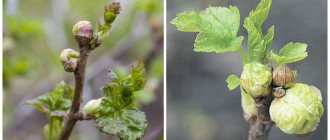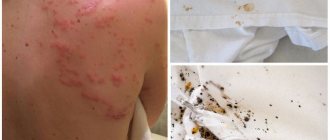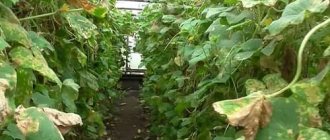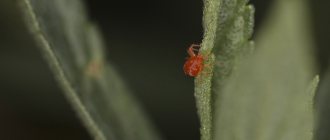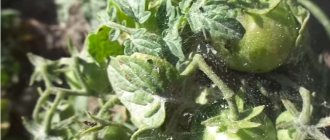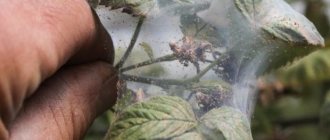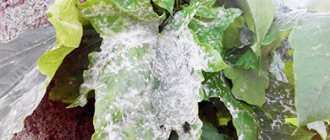Growing eggplants is a labor-intensive task, they are famous for their tenderness and capriciousness, are often susceptible to disease, and pests are especially fond of them. Therefore, the appearance of a spider mite on eggplants, this small insect sucking juice from the leaves, is, although not the only, but a dangerous problem that threatens the rapid death of a young vegetable.
Removing spider mites that have settled on eggplants is not an easy task, since the life cycle of these arachnid green “gourmets” is quite short, and several generations that have changed during the season can get used to one type of poison that was used to treat vegetables in the past.
The spider mite requires you to immediately begin to fight it, both in the greenhouse and in the open ground, also because if it multiplies quickly on your favorite eggplants, other crops planted in the neighborhood may also suffer, because its “menu” includes more 200 plants.
Signs of spider mites
Signs of spider mites on eggplants
Visible signs of spider mite damage to eggplants can be noticed when the pest has already thoroughly settled on the bush. Due to its tiny size, this arthropod is difficult to identify immediately. The back sides of the leaves are the first to suffer, then the pest moves to the stems and young shoots.
The presence of a mite is determined by the appearance of the eggplant:
- Tiny light or colorless dots appear on the surface of the leaves; as they are damaged, they grow together into a faded marble pattern;
- Brown spots appear on the leaf blades, which dry out over time and turn into small holes;
- on the underside of the leaves you can see a thin cobweb, which, with severe damage, envelops the bush almost entirely;
- gradually the leaves lose turgor;
- from the affected leaves the mite moves to the fruits, and lightened specks also appear on them;
- eggplants lose their juiciness and elasticity.
In just two weeks, spider mites can completely destroy a plant. At first, the growth of the eggplant slows down, it looks depressed and painful, at the last stage the rhizome dries out, and the bush cannot be saved.
Description and life cycle of the pest
The spider mite is a representative of arachnids with a convex upper body and four pairs of legs. It is difficult to see with the naked eye what the pest looks like, since its average size is 0.5 mm.
Ticks gather in colonies, each of which contains hundreds of individuals. The color of pests changes under the influence of external factors. They are typically grey-green in early summer and orange-red from late summer to early spring. In adults, there are two red eyespots near the head, and numerous bristles cover the body.
The life cycle of a spider mite consists of several stages: egg, larva, nymph and adult. Completing the entire cycle takes from 8-20 or more days.
The most rapid development of ticks occurs at high temperatures (more than +28°C). Another favorable factor for accelerated reproduction of the pest is low humidity (no more than 55%). Adults move from plant to plant using webs.
The fertilized female spider mite spends the winter on plant debris and under the peeling bark of trees. In the spring, when the temperature rises to 12°C, it moves to the surface and settles on the underside of leaves (the first generation reproduces on weeds, the second and subsequent ones move to cultivated plants).
Having weaved a thick web, female mites lay greenish-transparent eggs, placing them one at a time in the web, which then become pearl-colored. The duration of this stage of development is directly related to air temperature.
The development of the larval stage occurs in the interval of 8-20 days. The body is hemispherical, length does not exceed 0.14 mm, three pairs of legs.
The nymph is almost similar to the adult, but smaller in size; at this stage there are already four pairs of legs.
The pest at all stages of development, with the exception of wintering females, causes harm to the plant. By piercing the epidermis from the underside of the leaf, it sucks out the leaf juice with chlorophyll grains from eggplants, which gradually lose their vitality.
Why are spider mites dangerous?
Spider mites are a very insidious and difficult to remove pest. The individual reaches the mature stage in just a week, after which it begins to produce its own kind. The colony grows exponentially, quickly taking over new plants. During a season, an average of eight generations of spider mites are hatched in a greenhouse or garden bed. Considering that each lives for 7-30 days, it is easy to guess that without appropriate control measures the plantings will soon come to an end.
Mites pierce leaf tissue and feed on plant sap. The plant quickly becomes deprived of water and essential nutrients. Photos of spider mites on eggplants were taken with high magnification; in reality, an adult individual rarely exceeds 0.4 mm in length.
In addition to the fact that the spider mite itself causes enormous damage to eggplant plantings, it is a carrier of many fungal and viral diseases, in particular:
- gray rot;
- late blight;
- anthracnose.
Eggplants weakened by mites no longer have sufficient immunity and in most cases are affected by infections.
The whitish viscous web covering the leaves and stems of eggplant does not transmit light well and slows down the process of photosynthesis. There is not enough organic matter and the plant stops growing.
We must pay tribute to the survivability of the spider mite. During cold weather, these representatives of arachnids burrow into the soil and fallen leaves, climb into the cracks and frames of the greenhouse. Larvae and adult females are able to survive at temperatures down to -30°C. With the arrival of warmth, they crawl out of their shelters and attack the planted eggplant seedlings, which are especially vulnerable to pests and diseases.
Where does it come from?
When trying to get rid of any pest, be it an insect or a disease, it is important to understand the mechanisms of its development, preferred conditions, biological cycle, weaknesses and strengths
Spider mites spread by air, on human clothing, garden tools, animal fur, and under their own power. It is quite difficult to prevent its appearance in a greenhouse, but it is quite possible to create unfavorable conditions for life and reproduction. It is known for certain that ticks do not like excessive shade; when daylight hours shorten, they hibernate. But at the same time, they easily hide in last year’s tops, tree bark, and upper layers of soil.
When favorable conditions occur - abundant lighting, low humidity and consistently high air temperatures - female spider mites are located on the above-ground part of the plant, beginning to weave it with a thin web. They are usually based on the bottom of the leaf. Spider mites begin to reproduce in dry and hot weather, not disdaining to create colonies on weeds.
The rate of development of young individuals is very dependent on air temperature: at 15-20°C - no more than two weeks; at 30°C - ripen in three days. At the same time, the lifespan of each individual is a minimum of 7 days and a maximum of 30. In one season, 8 generations of spider mites can change.
How to treat eggplants against spider mites
You can get rid of spider mites on eggplants using pesticides, biological and folk remedies. Each method has its pros and cons.
Chemical remedies for spider mites on eggplants
Eggplants, like other crops, are treated against spider mites with acaricide solutions. This is a group of chemicals that destroy specifically herbivorous mites.
Comment! The word "acaricide" comes from the Greek words "acari" - "mite" and "caedo" - "to kill".
The table below describes the most popular and effective preparations, appreciated by gardeners.
| Name | Active substance | Peculiarities |
| "Aktellik" | Pirimiphos-methyl | Universal organophosphorus insectoacaricide for contact and intestinal action. When a spider mite enters the body, it disrupts the functioning of its vital organs. If used systematically, it can cause addiction in the pest. |
| "Envidor" | Spirodiclofen | New generation contact insectoacaricide. The drug does not cause cross-resistance, is effective for populations resistant to other acaricides, and kills ticks at any stage of development. Has high adhesion |
| "Sunmite" | Pyridabene | A highly effective Japanese drug that acts at all stages of spider mite development. The cessation of all types of pest activity can be observed within 15 minutes. Ticks fall into a coma and can no longer harm eggplant plantings |
| "Neoron" | Bromopropylate (isopropyl-4,4′-dibromobenzilate) | Contact acaricide, effective at all mobile stages of spider mite development. Does not lose properties at low and high temperatures. Safe for bees and other beneficial insects |
| "Karbofos" | Malathion | Organophosphorus preparation of contact action. It affects the tick only when it comes into contact with the body of an arthropod. With regular use, spider mites develop immunity. |
Warning! When working with pesticides, it is imperative to use personal protective equipment.
Biological remedies for spider mites on eggplants
Biological products for combating spider mites on eggplants have the same effectiveness as pesticides, however, they are less aggressive to the environment and are not dangerous to humans and animals.
The basis of many bioacaricides are beneficial living microorganisms:
- bacteria;
- mushrooms;
- viruses.
Another component of the bioacaricide is plant extracts, which act as a fertilizer and fungicide. Using biological products on eggplants, you can immediately solve three problems:
- get rid of the hated spider mite;
- feed the plants;
- carry out prevention of fungal diseases.
| Name | Active ingredient or live culture | Peculiarities |
| "Fitoverm" | Aversectin C | A powerful product that shows results within five hours after spraying. Protection lasts for 20 days. Three days after the last treatment, eggplants are edible. Thanks to the presence of an adjuvant in protected soil, consumption can be significantly reduced |
| "Vermitek" | Abamectin | Bioinsectoacaricide of contact-intestinal action. Does not have phytotoxicity. Has a long protection period - up to one month |
| "Akarin" | Avertin N | Biological product with enteric contact action. It has a high rate of impact on pests. Already 8-16 hours after treatment, the tick stops feeding and loses motor activity |
| "Apollo" | Clofentesine | It has an ovicidal effect and is effective at all stages. Toxic effects continue for 30 days. Not dangerous for predatory mites and beneficial insects |
| "Bitoxibacillin" | Spores of Bacillus thuringiensis var. thuringiensis | Not a phytotoxic biological preparation. Can be used at any stage of plant development. The fruits are allowed to be eaten five days after processing |
An unusual biological method for controlling spider mites is the breeding of predatory mites (Phytoseiulus persimilis, Amblyseius californicus). They are sold in many garden centers. The gardener can only release them onto the eggplant foliage. During the day, one hunter mite destroys 4-6 adult spider mites and about 10 eggs. When there is no suitable food left, the acariphages die.
Folk remedies for spider mites on eggplants
The use of folk remedies is advisable if chemicals and biological products cannot be used or are not at hand. Such methods are effective for minor tick infestations, as well as for complex pest control. Their action is slow and more gentle; they are not dangerous for humans and pets.
Garlic
Crushed garlic cloves (3-4 pieces) are infused in 1 liter of water for two days. Before processing, the infusion is diluted with water 1:1. In calm, dry weather, spray the tops and soil surface.
Onion peel
100 g of onion peel is poured into 5 liters of water, covered with gauze and left in a cool place for five days. Eggplant plantings are sprayed after watering, after shaking the onion infusion.
Advice! For better adhesion to the leaves, you can add a little laundry soap to the infusion.
Mustard
To obtain a mustard infusion against spider mites, 60 g of powder is diluted in 1 liter of water. In three days it will be ready for use.
alder leaves
Dry or fresh alder leaves (200 g) are steamed with boiling water (2 l) and simmered over low heat for half an hour. Then the broth is cooled and allowed to brew for 12 hours, after which it is filtered and sprinkled on the eggplants.
Dandelion
One of the fastest ways to prepare an infusion against mites on eggplants is to use ordinary dandelion. The leaves and rhizomes are crushed, poured with boiling water and left for three hours. For 1 liter of water you need 100 g of grass. The strained, cooled infusion is sprayed onto eggplant bushes without diluting it with water.
Tobacco dust and ash
Tobacco dust is mixed with wood ash in equal parts. The dry mixture is sprinkled on the bushes twice a summer. 100 g of powder is consumed per 1 m².
Green soap
Green soap contains potassium salt, fatty acids and vegetable oils. 400 ml of the drug is diluted per 10 liters of water. To wash the leaves, you also use laundry soap diluted in water (20 g per 1 liter). Many gardeners advise spraying eggplant plantings with a solution of sulfur-tar soap (100 g per 10 l).
Ammonia
To prepare the solution 1 tbsp. l. ammonia is stirred in 10 liters of water. The plants are sprayed, trying to get it not only on the top, but also on the back side of the leaves.
Important! All treatments, regardless of the method of control, must be carried out after mechanically washing off the cobwebs and mites using a cotton swab, and completely drying the surface of the leaves.
Chemicals
The most effective method of dealing with spider mites on eggplants is the use of chemicals. This includes drugs whose action is aimed at destroying the pest. Before use, you should read the instructions.
Fitoverm
The drug Fitoverm operates on the basis of aversectin, which paralyzes pests. The product does not affect tick eggs, so re-treatment is necessary.
Fitoverm is not used with other drugs against ticks. The action of the main substance begins a few hours after treatment, when the nervous system of the pests is paralyzed.
Important! The death of insects from Fitoverm occurs on the third day. Stronger representatives die after 6 days.
After treatment against spider mites on eggplants in a greenhouse, the drug retains its properties for 20 days. In open ground, with intense precipitation, dew and high air humidity, this period is reduced to 6 days.
To get rid of the pest, prepare a solution containing 1 ml of Fitoverm per liter of water. Spraying is carried out every 20 days. This amount is enough to process 10 square meters. m landings.
Bitoxibacillin
The drug Bitoxibacillin is sold in powder form and allows you to effectively combat garden pests. The product is effective against larvae and adults.
After using Bitoxibacillin, the death of the pest occurs within 3-5 days. After a week, repeated treatment is carried out to eliminate the colony of new mites.
Advice! The drug should not come into contact with the skin and other organs. Therefore, the use of protective equipment is mandatory.
100 g of the product are diluted in a bucket of water, after which the eggplants are sprayed. Bitoxibacillin is used before and during flowering, the appearance of ovaries and fruits. It is not allowed to carry out treatment a week before harvest.
Aktellik
Another option for treating eggplants against spider mites is Actellik. The drug acts on pests through the intestinal contact method. Depending on weather conditions and the period of development, ticks die within a few minutes or hours.
After treatment, the effect of Actellik lasts for 2 weeks. Treatment is carried out in the absence of rain and wind, at an ambient temperature of +12 to +25°C.
Important! For spraying eggplants, the Actellik concentration is 1 ml per liter of water.
The consumption of the drug is determined from the norm of 1 liter of solution for every 10 square meters. m. When used in open ground, the specified norm is doubled.
Neoron
Neoron is a drug whose action is directed against various types of ticks. The product copes with the pest at all stages of its development, from the larva to the adult. The drug partially affects tick laying.
Important! Based on Neoron, a solution is prepared consisting of 1 ml of the substance and 1 liter of water.
Eggplants have always been treated with chemicals leaf by leaf. Neoron can be used with non-alkaline drugs. Its effect lasts for 10-40 days depending on external conditions. Insect death occurs within several hours after contact with treated plants.
Nissan
The action of this drug is aimed at tick eggs and larvae. The result of its use is noticeable on the 10th day. To process eggplants, prepare a 1% solution.
Sunmite
The drug is available in the form of a white or light brown powder. Sunmite acts on various types of mites, including spider mites.
The active ingredient of the drug is pyridabene, which causes paralysis of insects. It is recommended to use the drug on a cloudy day, since its active ingredient is destroyed in direct sunlight.
Important! After treatment, Sunmite remains effective for 3 weeks.
The product acts on ticks regardless of the stage of development and does not cause addiction in insects. The effect of using Sunmite is observed within 15 minutes after treatment.
To solve the question of how to get rid of spider mites, a working solution is prepared. It is obtained by dissolving 1 g of the substance in 1 liter of water. Processing is carried out using the sheet method.
Floromite
The product is directed against larvae and adult ticks. It takes 3 days to completely destroy the pest. After treatment, the effect of its use lasts for 3 weeks.
To prepare the solution you will need 4 ml of Floromite per 10 liters of water. No more than 2 treatments are carried out per season.
Colloidal sulfur
Using colloidal sulfur you can stop the spread of spider mites. The substance is not used during the flowering period of eggplants. The last treatment is carried out at least three days before harvest.
Important! The protective properties of sulfur last for 10 days. The first results can be observed after 3 days.
To combat spider mites on eggplants, prepare a solution containing 40 g of the substance and 5 liters of water. First, colloidal sulfur is diluted with a small amount of water, thoroughly ground and mixed.
Add 0.5 liters of water to the resulting mass and mix until a solution of homogeneous consistency is obtained. Then add the remaining 4.5 liters of water. Gloves are used when working with colloidal sulfur.
Agrotechnical measures to combat spider mites on eggplants
Spider mites are active and multiply rapidly under certain environmental conditions. The most favorable conditions for it are low humidity (less than 55%) and high temperature.
An important agrotechnical measure in the fight against spider mites is digging up the soil near the bushes to a depth of 5-8 cm. Row spacing is plowed to a depth of 10-15 cm.
To maintain the required soil moisture, you need to adjust the watering regime for eggplants. Young plants are watered 1 liter per bush twice a week, adults - once a week, spending 2-3 liters. When the eggplants are at the stage of ovary maturation and are actively bearing fruit, watering is carried out 2-3 times a week.
After the moisture has been well absorbed, the soil is loosened, removing weeds. Mulch from compost or grass is poured under the bushes; the layer height should be at least 8 cm. Gradually overheating, it will create a moist and warm environment in which ticks will be uncomfortable.
You can also treat eggplants with a decoction of onion peels.
To prepare the decoction, take a liter jar, fill it to the brim with onion peels, pour the resulting amount into the pan and add water at the rate of one liter, put it on the fire, as soon as it boils, boil for five minutes, remove and let cool, then strain the decoction, pour it into a bucket and add water at the rate of 10 liters, spray the plants with this solution.
There are several ways to combat spider mites on eggplants, but we should not forget about effective preventive measures.
Preventive actions
Prevention of spider mites in closed and open ground is somewhat different. For greenhouses, the following rules must be observed:
- The greenhouse should be regularly ventilated and the eggplants should be sprayed with warm water.
- Before planting and after harvesting, the soil in the greenhouse must be disinfected.
- Many experienced gardeners recommend annually changing the top layer of soil in the greenhouse - this is where spider mites like to spend the winter.
- To destroy pests in the fall, place a smoke bomb in the greenhouse and close all doors and vents.
- You can go over the frame of the structure with a blowtorch, but be very careful so as not to burn or melt anything.
In open ground conditions it is important:
- Maintain crop rotation.
- In autumn and spring, dig up the soil at least 20 cm, adding organic fertilizers and copper sulfate.
- Carry out preventive treatments with onion, garlic or soap solution four times a season.
Mistakes of novice gardeners
Mistakes gardeners make when fighting spider mites:
- Dry air is the main condition for the appearance of mites, so plants in the greenhouse should be sprayed with warm water, especially if it is stuffy outside. Greenhouses must be ventilated.
- When fighting a pest, preventive measures are required. The area where the tick has parasitized is treated with Fitoverm. Eggs and larvae remain in the ground, which do not die at low temperatures, so in the spring of next year the mite will again parasitize nightshade crops.
- To combat the pest, do not forget about regular weeding and removing the remains of dead crops.
- Start fighting the pest with traditional methods that are safe for humans. If they are not effective, proceed to the use of chemicals.
- Only acaricides and insectoacaricides will be effective for controlling ticks. It is useless to use insecticides; they are suitable for insect pests, but spider mites do not belong to this group of pests.
Rate the quality of the article. We want to be better for you:
Pesticide Information
Drug: the name of the pesticide, its formulation, content of active substance, registrant, state registration number, restrictions and expiration date of registration are indicated. Numerical designations separated by fractions from (1) to (4) after the registrant indicate the hazard classes of the drugs. The numerator is the hazard class for humans, the denominator is for bees in field conditions. (P) - prohibition of use in the sanitary zone around fishery reservoirs at a distance of 500 m from the flood line at the maximum standing of flood waters, but not closer than 2 km from the existing banks . For pesticides intended for pre-sowing treatment of seeds, it is prohibited to treat seeds in the specified zone; sowing of treated seeds is permitted.
Application rate: the application rates for pesticides are indicated (by preparation): for solid formulations – in kg/ha (for seed protectants – in kg/t), for liquid formulations – in l/ha (for seed protectants – in l/t ). In other cases, application rates given in other units of measurement are indicated next to the numerical value of the pesticide application rate. The application rates for herbicides are given based on continuous tillage; with the belt application method, the application rate is reduced in proportion to the decrease in the cultivated area. (A) - permission for aerial treatments in these application regulations. (L) - permission to use the drug on private farms. Regulations for the use of the drug on private farms are presented in a separate line.
Culture: Cultures are indicated. Two crops, for example, tomato and cucumber, are indicated for both open and protected ground, unless specifically stated.
Harmful object: harmful objects against which this pesticide is recommended are indicated; for desiccants and plant growth regulators - the purpose of the drug.
Method, processing time, application features: the method, processing time, application features are posted. The expression “Consumption – 400 l/ha”, “Consumption – 12 l/t”, etc. means the flow rate of the working fluid (solution, emulsion or suspension), unless “Working fluid flow rate” is indicated.
Waiting period (number of treatments): waiting times are indicated, with the number of treatments in parentheses. The waiting period is the time interval between treatment with the drug and harvesting, indicated in days. If the use of a pesticide is clearly one-time, for example, pre-sowing seed treatment, then a dash (-) or (1) may be indicated in the sixth column.
Time limits for manual (mechanized) work: the time for people to enter areas treated with pesticides to carry out manual (mechanized) work to care for plants is given in days.
Advice from experienced summer residents
Gardeners with extensive experience recommend keeping the garden clean and tidy and being attentive to your plantings. In a clean and well-kept garden, plants rarely get sick and have strong immunity.
Some tips to help deal with ticks:
- It is better to pluck damaged parts of seedlings without sparing them.
- Don't rush into using strong chemicals. It is better to resort to their help only in case of severe damage.
- It is useful to spray the seedlings with a solution of ammonia (2 tsp per 1 liter of water).
- Cobwebs must be removed immediately.
- Increase the humidity greatly (at 90-95% the eggs die).
How to fight in a greenhouse and open ground
It is a little easier to overcome spider mites in a greenhouse. It is easy to control humidity and air temperature here. Sometimes even simple preventive measures and folk methods are enough. But you need to be careful with chemicals in the greenhouse. Strongly toxic substances should absolutely not be used. Colloidal sulfur is excellent for greenhouses.
In open ground, it is possible to control climatic conditions only partially: cover the plantings from rain or strong winds, or protect them from animals.
At the same time, it is permissible to use any drugs on the street. But it is better to give preference to low-toxic ones, because poisons also affect the plant.

